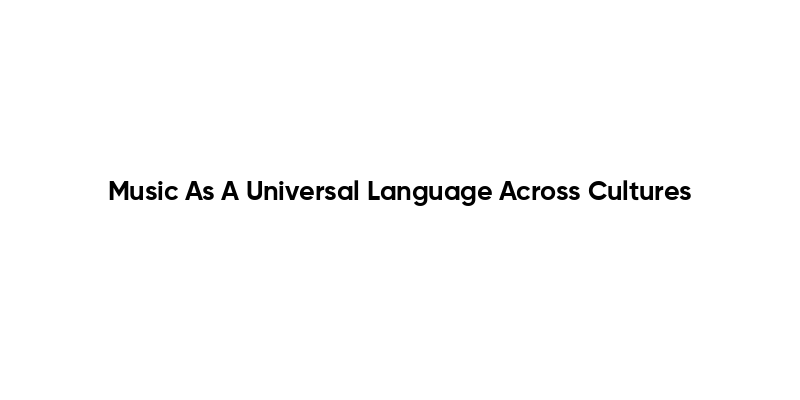The Emotional Power of Music
Music has an unparalleled ability to evoke emotions, transcending linguistic barriers. Across cultures, melodies and rhythms can express feelings of joy, sorrow, love, and anger. This emotional resonance allows individuals from different backgrounds to connect on a deeper level, often without the need for words. For instance, a simple lullaby can soothe a child regardless of the language it is sung in, highlighting music’s universal appeal.
Moreover, studies have shown that certain musical elements, such as tempo and harmony, can elicit similar emotional responses across diverse cultures. This phenomenon suggests that music taps into fundamental human experiences, making it a powerful tool for communication and understanding. As a result, music often serves as a bridge between cultures, fostering empathy and shared experiences.
Music in Cultural Identity and Heritage
Music plays a crucial role in shaping cultural identity and preserving heritage. Traditional songs and dances are often passed down through generations, serving as a means of storytelling and cultural expression. For many communities, music is a vital aspect of rituals, celebrations, and social gatherings, reinforcing a sense of belonging and continuity.
In this context, music acts as a repository of history and tradition, allowing individuals to connect with their roots. For example, indigenous music often incorporates elements of nature and spirituality, reflecting the community’s relationship with the environment. By celebrating and sharing their musical heritage, cultures can promote understanding and appreciation among diverse groups, further emphasizing music’s role as a universal language.
The Role of Music in Social Movements
Throughout history, music has been a powerful catalyst for social change. From protest songs to anthems of liberation, music has inspired movements and united people in their quest for justice and equality. The ability of music to convey messages of hope and resistance makes it an essential tool for activists across the globe.
For instance, during the Civil Rights Movement in the United States, songs like “We Shall Overcome” became rallying cries for change. Similarly, contemporary movements, such as those advocating for climate action, often use music to raise awareness and mobilize support. This demonstrates how music can transcend cultural boundaries, fostering solidarity and collective action in the face of adversity.
Cross-Cultural Collaborations in Music
In today’s globalized world, cross-cultural collaborations in music are becoming increasingly common. Artists from different backgrounds come together to create unique sounds that blend various musical traditions. These collaborations not only enrich the musical landscape but also promote cultural exchange and understanding.
For example, the fusion of African rhythms with Western pop has led to the emergence of genres like Afrobeat, which has gained international popularity. Such collaborations highlight the adaptability of music as a universal language, allowing artists to share their cultural narratives while appealing to a broader audience. This exchange fosters appreciation for diversity and encourages dialogue among different cultures.
The Impact of Technology on Global Music Sharing
Advancements in technology have revolutionized the way music is created, shared, and consumed. The internet and social media platforms have made it easier for artists to reach global audiences, breaking down geographical barriers. As a result, music from various cultures can be accessed and appreciated by people worldwide, further solidifying its status as a universal language.
Streaming services and online platforms allow listeners to explore diverse musical genres, promoting cross-cultural understanding. Additionally, technology enables artists to collaborate remotely, creating innovative works that reflect a blend of influences. This accessibility not only enriches the global music scene but also fosters a sense of community among listeners and creators, reinforcing the idea that music truly is a universal language.
| Aspect | Description |
|---|---|
| Definition | Music is often described as a universal language that transcends cultural and linguistic barriers, allowing people to communicate emotions and ideas. |
| Cultural Significance | In many cultures, music plays a vital role in rituals, celebrations, and social gatherings, serving as a means of expressing identity and community. |
| Emotional Connection | Music evokes emotions and can create a sense of connection among individuals, regardless of their cultural backgrounds. |
| Cross-Cultural Influence | Musical styles often blend elements from different cultures, leading to the creation of new genres and fostering mutual appreciation. |
| Communication | Music can convey messages and stories, often more effectively than words, making it a powerful tool for communication. |
| Globalization | The rise of technology and social media has facilitated the global exchange of music, allowing diverse musical traditions to reach wider audiences. |
| Therapeutic Benefits | Music therapy is used across cultures to promote healing and well-being, highlighting its universal impact on mental health. |
| Conclusion | Music serves as a bridge between cultures, fostering understanding and unity among people from different backgrounds. |



